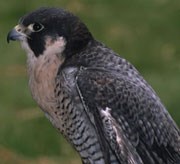
D. Herr/U.S. Forest Service Yosemite National Park’s special status bird listings can come from state and federal designations. Four bird-related state ratings apply in Yosemite right now, with the newest listing–-California Bird Species of Special Concern–-incorporating a higher degree of scientific evidence. (No federally listed designations currently apply in Yosemite.) The following Yosemite National Park’s bird species carry a special status declared by the state (view definitions of special status categories):
Willow flycatcher—CE 
D. Gomez/U.S. Forest Service American Peregrine Falcon's SuccessThis bird of prey is a symbol of a recovering species. In August 1999, the U.S. Fish and Wildlife Service removed the American peregrine falcon from the list of endangered and threatened species, marking one of the most dramatic successes of the Endangered Species Act. In November 2009, the peregrine was removed from California’s endangered species list, 10 years after it was federally delisted. Yosemite National Park represents the highest peregrine falcon nesting density in the Sierra Nevada and has played a key role in its recovery since 1978. In 1994, six of 14 pairs in the Sierra Nevada south of Lake Tahoe nested in Yosemite. Active management for recovery of the peregrine has occurred in Yosemite since 1978, including the monitoring of known nest sites; surveying for additional nest sites; removing of damaged eggs for laboratory hatching and rearing; fostering of laboratory-reared chicks into active nest sites; releasing of young into the wild; doing pesticide analysis of eggshells and eggs for population health assessment; and restoring habitat protection. The Santa Cruz Predatory Bird Research Group coordinated much of this effort. Peregrine falcon records in Yosemite date back to 1940 and are notably absent from 1949 to 1975, corresponding with the noted decline and reappearance of the bird nationally. Peregrines were first re-discovered in Yosemite in 1978, breeding on El Capitan. Since the 1980s, climbing closures have often been in place to protect the breeding pairs.
Visit our keyboard shortcuts docs for details
The peregrine falcon thrives in Yosemite Valley, but this remarkable bird was temporarily extirpated from much of its native range, including Yosemite where it disappeared for decades, leading to its listing as an endangered species in the early 1970s. Because of the remarkable, collaborative efforts of Yosemite climbers, UCSC Predatory Bird Research Group, and NPS biologists, with generous funding from the Yosemite Conservancy, the story of Yosemite’s peregrine falcon is one of hope. More Information
|
Last updated: April 6, 2022
